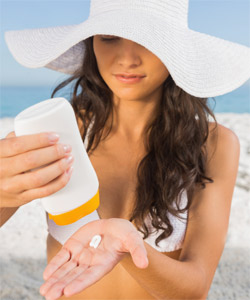|
 ,
,
Font size |
20 Ways to Cut Your Cancer risk

Most people are well aware of the substantial
risks of cancer from tobacco
smoke. But do we also have to worry about acrylamide,
a likely carcinogen in foods that's received a lot of press lately? Or
about exposure to nickel, beryllium, and other industrial compounds?
An estimated 5 to 10 per cent of cancer risk, lower than
previously thought, stems from genetic factors. Those with a strong family
history of cancer can use that knowledge to focus on the particular risk factors
to guard against. It is possible, for example, that some people may be
especially sensitive to low levels of carcinogens in foods, the environment, and
consumer products. And, because a lot of small risks can add up over a
lifetime, it makes sense for everyone to try to avoid as many as possible.
Over a third of cancers are influenced by smoking,
nutrition, physical inactivity,
obesity, and other lifestyle factors, and could
be prevented," says Len Lichtenfeld, M.D., spokesman for the cancer control
science department at the ACS national headquarters in Atlanta.
Here are the practical steps you can take to reduce your exposure to
carcinogens and to help prevent cancer.
1.
Check
for asbestos
If you live in home that dates back a
couple of decades or more, there may be insulation or other material
containing the carcinogen asbestos. Be sure to check out a comprehensive
list of asbestos related products if you are worried that you might be
at risk. If the material has deteriorated to
the point where fibres could
escape into the air, it should be removed by a qualified contractor.
Otherwise, it's usually best to leave it alone.
2.
Assess your workplace
If you work with chemicals or cancer hazard, such as wood dust, take the
proper precautions, which may include wearing protective masks, gloves, or
other clothing, and ensuring your work-place is properly ventilated.
Painters and furniture makers may be at increased cancer risk from inhaling
carcinogens from paint thinners and wood dust. People who work at a dry
cleaner's should know that studies suggest a possible link between
occupational exposure to the chemical perchlorethylene and a few cancers, including lymphomas
and cancer of the larynx and urinary bladder. And hairdressers exposed to
certain dyes might also be at higher risk. Talk to your doctor and
employer about concerns for workplace safety information.
3.
Have your water tested
Get your town municipality to provide regular reports on the safety of
drinking water in your area. Consuming water contaminated by chemicals
like PCBs, trihalomethanes, etc. may increase the risk of cancer
and other problems.
4.
Listen to air-pollution
reports
Thousands of chemicals, including suspected carcinogens, escape from
industrial smokestacks. A few carcinogens, such as benzene, are
belched out in car exhaust. Unfortunately, air quality is generally
not monitored for these chemicals. But factors that favour ozone buildup
and lead to smog alerts probably cause these chemicals to build up too.
Peter Greenwald, M.D., director of the Division of Cancer Prevention at the
National Cancer Institute ( NCI ) in Bethesda, Md, advises against exercising
outdoors near high traffic areas and on polluted days. If you have
breathing problems, try to stay indoors during smog alerts.
5. Don't breathe smoke
 Of course, cigarette smoking
is by far the most important risk factor for lung cancer, as also cancers of the
mouth, stomach, pancreas, liver, kidney, bladder and more. Passive
exposure to secondhand smoke also is a significant cancer-risk factor. In
addition, several studies have linked second-hand smoke from spouses with an
increased risk of
cardiovascular diseases. To avoid secondhand smoke, ban
smoking in your house, car, and office. Of course, cigarette smoking
is by far the most important risk factor for lung cancer, as also cancers of the
mouth, stomach, pancreas, liver, kidney, bladder and more. Passive
exposure to secondhand smoke also is a significant cancer-risk factor. In
addition, several studies have linked second-hand smoke from spouses with an
increased risk of
cardiovascular diseases. To avoid secondhand smoke, ban
smoking in your house, car, and office.
6.
Exercise for at least 30
minutes daily
Physical activity for half an hour to 45 minutes five days a week may reduce
your risk of several cancers, notably colon and
breast cancer. It may
also prevent other conditions, such as heart disease,
diabetes, and
bone
loss.
7. Limit your red-meat
consumption
A diet heavy in red meat - eating it as the main dish most days of the week
- has been linked with and increased risk of some cancers, notably cancer of
the colon in many observational studies.
8. Eat your colours
Different -
coloured produce contain different phytonutrients, including antioxidants and other disease- fighting substances.
Foods rich in cancer - fighting phytonutrients include red peppers and tomatoes,
white onions and garlic, blue berries and plums, yellow peppers and sweet
potatoes, and green peas and cauliflower. Try to eat a variety of colours
each day. In general, choose a varied,
well-balanced diet that's high in
fibre and
low in fat with lots of fresh
fruits and vegetables.
9. Avoid pesticide
residues
Washing or peeling produce and removing the outer loaves of leafy vegetables
will reduce your exposure to these chemicals. So will buying
organic
foods when they're available and affordable. Organically grown corn
and strawberries appear to have significantly higher levels of
cancer-fighting antioxidants than conventionally grown foods, according to a
recent study published in the Journal of Agricultural and Food Chemistry.
The research suggests that pesticides and herbicides reduce exposure to
pesticides by using non-chemical methods of insect control in your house and
garden. For example, use lady bugs to keep rose bushes healthy.
10. Avoid charred meat
Cooking meat at high temperatures creates chemicals shown to cause cancer in
lab animals. You can reduce your exposure by removing fat before
cooking and by trimming away any charred portions.
11. Eat the right fish
 Some evidence suggests that
eating fish may reduce the risk of certain
cancers. While fatty fish is healthy source of protein and
heart-healthy omega-3 fatty acids, some species accumulate contaminants like
PCBs and mercury from polluted waters. So it's best to limit
consumption of fatty fish such as carp, catfish, bass, king mackerel, shark,
and swordfish to about twice a week. Some evidence suggests that
eating fish may reduce the risk of certain
cancers. While fatty fish is healthy source of protein and
heart-healthy omega-3 fatty acids, some species accumulate contaminants like
PCBs and mercury from polluted waters. So it's best to limit
consumption of fatty fish such as carp, catfish, bass, king mackerel, shark,
and swordfish to about twice a week.
12. Go easy on fried foods
In April 2002, Swedish researchers discovered relatively high levels of acrylamide, a likely carcinogen, in certain fried foods,
especially french fries and potato chips.
13. Consider avoiding
alcohol
Moderate drinking can help
protect against heart disease. Unfortunately, studies also show that
even a drink of two a day of wine, beer, or liquor can slightly increase a
woman's risk of breast cancer; 2 to 5 drinks a day ups the risk 1.5 times
that of teetotalers. Preliminary research suggests you may be able to
get at least some of wines heart benefits from drinking purple-grape juice.
14.
Avoid unnecessary X-rays
It's OK to inform your doctors and dentists that you don't want X-rays
unless they are truly medically necessary. If you change dentists,
bring a copy of your most recent dental X-rays with you and ask that they be
put on file.
15. Request lowest-dose
imaging
Ask your radiologist to use the lowest radiation dose necessary to get a
clear image. It's especially important if a CT scan is ordered for a
child or any small-framed individual, say Consumers Union's medical
consultants. U.S. health authorities recently raised a concern that
children these days are being exposed to too much radiation, and said a
single CT scan can deliver as much radiation as 100 standard X-rays.
16.
Check for infection
-
Stomach cancer.
If you have a family history of
stomach cancer, talk with your doctor about whether you should be tested for
the ulcer-causing bacterium, H. pylori. Studies suggest the common bug
also contributes cancer by chronically inflaming the stomach lining. If
you're infected, talk with your doctor about antibiotic treatment.
-
Cervical Caner. See your doctor to be tested for human papillomavirus (HPV), if you notice warts in the genital area, and chlamydia.
Both of those common sexually transmitted infections are linked with higher
risks of cervical cancer.
-
Liver Cancer.
Ask your doctor about getting tested for
hepatitis C if you are having liver problems, have used illicit intravenous
drugs, or had a blood transfusion in the early 90s, when screening for this
virus was unavailable. The virus, which often causes no outward
symptoms, can stay active for decades before leading to liver cancer.
17. Reduce your exposure to sun
 Reduce your
exposure to sun and its
solar radiation to cut your risk of deadly
melanoma dramatically. Reduce your
exposure to sun and its
solar radiation to cut your risk of deadly
melanoma dramatically.
"Some people have estimated that for certain skin types," Dr. Anderson
(Professor at the Medical College of Wisconsin as well as the American Cancer
Society Professor of Clinical Oncology.) said, "you could reduce the risk of
melanoma by 75 percent if you protect yourself throughout your lifetime. People
with fair skin are most susceptible.
18. Practice safe sex.
For example, the more partners a woman has, the greater risk she has for
herpes-like viruses that cause many cervical cancers. Avoiding infection
with the HIV virus lowers cancer risks also.
19. Keep salt intake to 6 grams a day or less
People who eat lots of highly salted food double their risk of stomach
cancer, research
suggests. Scientists from Japan's National Cancer Centre Research Institute
carried out an 11-year study of 40,000 middle-aged Japanese. The risk of stomach
cancer was one in 1,300 per year for those who ate the highest amount of salt,
compared to one in 2,000 for those with a relatively salt-free diet.
20. Water May Cut Bladder Cancer Risk
Drinking more of any fluid seems to lower bladder cancer risk, but water
decreases risk the most. Drinking more helps your bladder in two ways. The fluid
dilutes carcinogens in the bladder, and the more you drink, the more you run to
the bathroom, which rids your bladder of carcinogens at a faster rate.
Dr. Michaud (researcher at The Harvard School of Public Health) recommends
men--and women--add two or three glasses to their daily water intake, for a
total of nine or ten glasses a day. Drink up!
Roughly 39 per cent of women will develop a potentially life-threatening cancer
in their lifetime, according to the American Cancer Society (ACS). However,
Regular cancer screening tests can help ensure that many forms of cancer
are caught at an early enough stage to be effectively treated.
Dated 23 February 2008
Related Links
|









